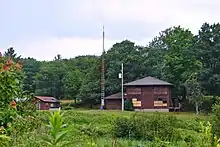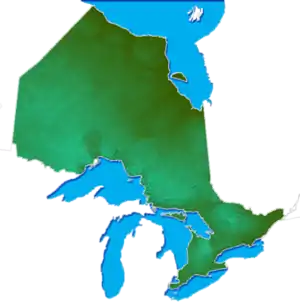La Cloche Provincial Park
La Cloche Provincial Park is a provincial park at the boundary of Algoma and Sudbury Districts in Ontario, Canada.[2] The park consists of an unspoiled section of the La Cloche Mountains that stretch along the North Channel of Georgian Bay, as well as several islands in the channel (which are mostly part of Manitoulin District).
| La Cloche Provincial Park | |
|---|---|
IUCN category II (national park) | |
 Riviere La Cloche | |
 | |
| Location | Unorganized SE Algoma, Sables-Spanish Rivers |
| Nearest town | Massey, Ontario |
| Coordinates | 46°06′18″N 82°01′30″W |
| Area | 7,448 ha (28.76 sq mi)[1] |
| Established | 1985 |
| Governing body | Ontario Parks |
| Website | www |
Notable features of the park include the site of the former Fort La Cloche trading post and diabase dykes cutting through older Lorrain, Gowganda, and Bruce formations, as well as ridge and terrace forests, and various wetlands and shoreline vegetation.[1] The park surrounds most of La Cloche Lake, which drains into the North Channel via the Riviere La Cloche (La Cloche River).[3][4][5]
The park borders the La Cloche Ridge Conservation Reserve to the east, which also protects a rugged portion of the La Cloche Mountains and forms a natural corridor to Killarney Provincial Park further east. The approximately 40-kilometre (25 mi) long Heaven's Gate Trail stretches from Fort La Cloche in the park through the conservation reserve to Highway 6 at Willisville.[6]
It is a non-operating park, meaning there are no facilities or services.[1]
History

Fort La Cloche (46°6′48″N 82°4′36″W[7]) was established probably around 1790 by the North West Company along the fur trade route, about 10 miles (16 km) east of the mouth of the Spanish River. The post was named after a rock, which rung like a bell (French: la cloche) when struck.[8]
When the North West Company merged with the Hudson's Bay Company in 1821, the post continued to operate as a HBC post. It was the district's headquarters and at that time the principal and only permanent post in the Lake Huron District. By the end of the 1820s, it consisted of the Chief Factor, one clerk, and four labourers. It faced competition from two "free traders" nearby, who abandoned their trading posts by 1832. In September of the following year until June 1834, a measles epidemic broke out in the district, claiming the lives of one man, seven women and eight children at La Cloche.[8]
By winter 1834-35 the trading post staff had grown to one Chief Factor, one boat builder, one blacksmith, four men, and one apprentice boy.[8] In 1836, the post was described as "the first and only signs of civilized society ... The factory consists of a large log-house and extensive store to contain the goods bartered with the Indians, and huts inhabited by work peoples, hunters, voyageurs and others; a small village in short." It was the main commercial centre in the district, and a seasonal settlement and economic hub for the local First Nations.[5]
When the Canadian Pacific Railway reached Sudbury in the 1880s, the post lost its importance and appears to have been closed in 1888. Nothing of the original post has remained.[5][9]
In 1968, the Department of Lands and Forests acquired the land for $150,000 and a Junior Rangers camp was constructed at the location of Fort La Cloche. Along with a tourist lodge, this operated there for a number of years and closed before the area became a provincial park.[5][10]
See also
- Henry John Moberly - fur trader at Fort La Cloche
- Sagamok Anishnawbek First Nation - directly west of La Cloche Provincial Park
References
- "Welcome to La Cloche Provincial Park". www.ontarioparks.com. Ontario Ministry of the Environment, Conservation and Parks. Retrieved 1 December 2020.
- "La Cloche Provincial Park". Geographical Names Data Base. Natural Resources Canada.
- "La Cloche Lake". Geographical Names Data Base. Natural Resources Canada.
- "Rivière La Cloche". Geographical Names Data Base. Natural Resources Canada.
- Jim Moodie (31 May 2015). "Fur trade echoes at Fort La Cloche". thesudburystar.com. Sudbury Star. Retrieved 2 December 2020.
- "La Cloche Ridge Conservation Reserve Resource Management Plan" (PDF). Ministry of Natural Resources. October 2005. Retrieved 7 December 2020.
- "Fort La Cloche". Geographical Names Data Base. Natural Resources Canada.
- "The History of Fort La Cloche". willisville.ca. 19 December 1934. Retrieved 2 December 2020.
- "HBCA Post Records By Number". www.gov.mb.ca. Hudson's Bay Company Archives, Archives of Manitoba. Retrieved 2 December 2020.
- La Cloche Provincial Park Interim Management Statement (PDF). Ministry of Natural Resources of Ontario. March 1994. ISBN 0-7778-2391-8.
